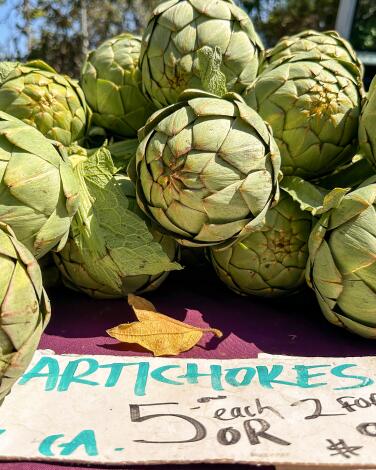This must be Venice
The casual observer might find a disconnect between Venice’s two most defining elements: a network of European-style urban canals with quaint arched bridges and paddling ducks, and a carnival-worthy boardwalk where strongmen flex, vendors offer to inscribe your name on a grain of rice and gravity-defying skateboarders launch themselves skyward.
Both, though, flow from the vision of a New Jersey-born developer named Abbot Kinney (as in the area’s popular shopping thoroughfare) who, having made millions in the tobacco trade, sunk a good deal of it into the coastal marshlands here to create a city modeled after its Italian namesake, right down to the canals and gondolas. As of July 5, 1905, Venice of America was open for business. But ever the consummate businessman, Kinney also provided a more immediate attraction to lure visitors; an amusement pier that jutted out over the water, filled with the kinds of rides, attractions and spectacles that would establish it as the Coney Island of the Pacific.
Get to know Los Angeles through the places that bring it to life. From restaurants to shops to outdoor spaces, here’s what to discover now.
Through more than a century of cyclical busts and booms, the seaside community shifted and changed; after its infrastructure fell into disrepair, the independent city was annexed by Los Angeles (in October 1925), many of the original canals were filled in (1929) and the amusement piers would burn (1920 and 1924) and shutter (1946). What remained are the two most visible reminders of that bygone era; a half-dozen canals and a boardwalk that continues to radiate BPE — big pier energy — with an estimated 28,000 to 30,000 people visiting each day.
In between those two tourist-attracting caricatures is a much more nuanced version of Venice: the indie bookstores, top-notch taco shops, dimly lit bars, fancy restaurants and human-powered carousels that fill the bellies and nourish souls of those who call Venice home. As idyllic as that all sounds, the city-turned-neighborhood isn’t immune from the problems that come with haves and have-nots living cheek by jowl in near-paradise; crime, a lack of adequate parking and stalled projects aimed at helping the substantial unhoused population.
As one of my Venice-dwelling colleagues told me when I first began to explore the neighborhood: “I should tell you Venice is more than just the beach.” And she’s right. For a different view of Venice, read on.
What's included in this guide
Anyone who’s lived in a major metropolis can tell you that neighborhoods are a tricky thing. They’re eternally malleable and evoke sociological questions around how we place our homes, our neighbors and our communities within a wider tapestry. In the name of neighborly generosity, we included gems that may linger outside of technical parameters. Instead of leaning into stark definitions, we hope to celebrate all of the places that make us love where we live.

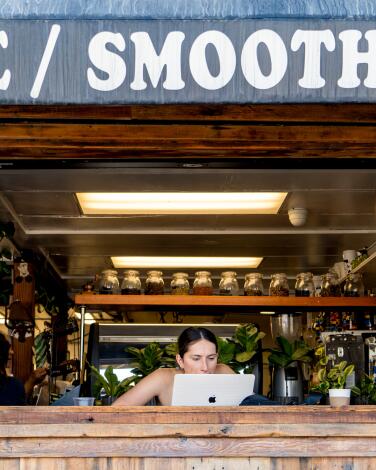
Greet the day like a local at the Cow's End Cafe
Opened in 1989, the interior is packed to overflowing with cow kitsch decor (think cow creamers, figurines, cookie jars and the like) and a full-size cow statue grazes contentedly, full udder bulging, in the window above the front door. The menu is just as packed, with all manner of sandwiches, salads, wraps, bowls and beyond. But you’re here for the served-all-day breakfast, a pastry from the glass case at the counter, a tortilla-wrapped breakfast (a wrapp with an inexplicable extra “p”) or a baker’s dozen of bagel sandwich options. Grab something simple — the bagel egg sandwich that layers in bacon and cheddar is breakfast comfort food at its finest — then go a little wild in the coffee drink department (lattes with a dash of banana-flavored or coconut -flavored syrup seem to be a thing here). Enjoy until the cows come home.
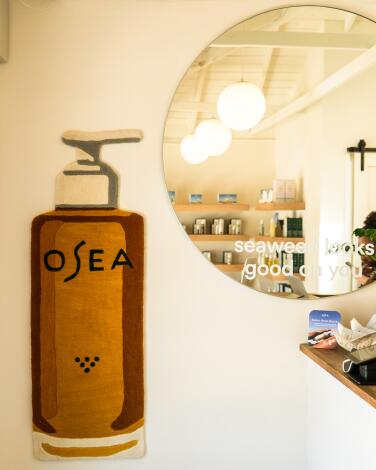
Get a celeb-worthy facial at OSEA Skincare Studio
On a recent visit, an aesthetician named Christina gave me something called a cranial wave facial, which started with an assessment of my skin (including a gentle reassurance that my pores, which I believed to be freakishly large, were in fact normal). From there, it was a gentle, almost tender series of steams, slathers and serums interrupted by the occasional pinch of extraction and scrub of exfoliation. From time to time during the 50-minute treatment, Christina cradled my head in her hands and gently kneaded my neck (craniosacral therapy is based on these kinds of manipulations). The result? I left with a glow and a notecard with a detailed daily skincare regimen I could follow to keep putting my best face forward.
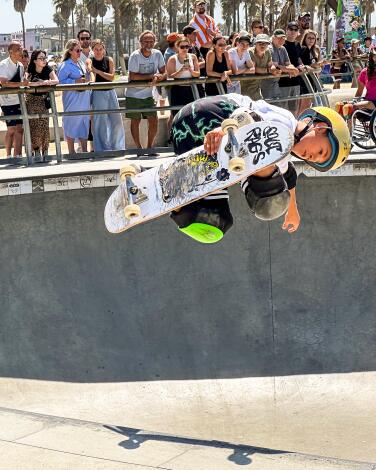
Make an early morning pilgrimage to Venice Beach Skate Park
Most times of the day, you’ll find it as colorfully chaotic — if perhaps more gravity-defying — as the nearby boardwalk, filled with skaters of considerable skill flinging themselves skyward with abandon. But if you make the effort to come here very early in the morning (as I recently did on the advice of a colleague), it can be as serene as a Zen garden. Before 9 a.m. you’ll find few people, perhaps a city worker daubing graffiti from sidewalks and tree trunks with a paint brush, a single boarder dipping lazily into the bowl while two helmeted acolytes kneel next to their boards and look on with rapt attention. Soon they will deign to throw themselves skyward too, from this sacred skater spot on the sand. And, if you linger long enough, you’ll see it happen.
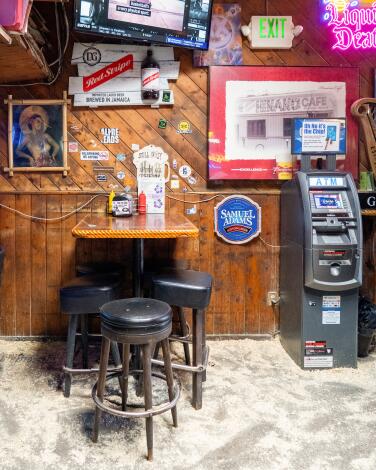
Duck into quintessential dive bar Hinano for a burger and a brew
You could eat your burger (which you definitely should order, even if it’s only to feed your curiosity about the world-famous thing) and sip your draft beer at one of the outside tables with a view of the Venice Pier not too far away. But that would deprive you of the frozen-in-time interior, where bar signs compete with surf stickers for attention, a Nicolas Cage movie blares from a bigscreen TV (Nicolas Cage should be the patron saint of dive bars, just sayin’), and the brightest light in the place is the buttery yellow glow of an old-school popcorn machine that beckons from the back corner. Are those sparkly red, white and blue streamers strung above the register left over from Memorial Day? Fourth of July? This year? This decade? Does it really matter? What matters is that this dive bar has been crusted like a barnacle on the hull of the city’s western edge for more than 60 years and feels like it could easily go another 60. The only concession to the changing times? Once famously cash-only, Hinano now accepts debit and credit cards.
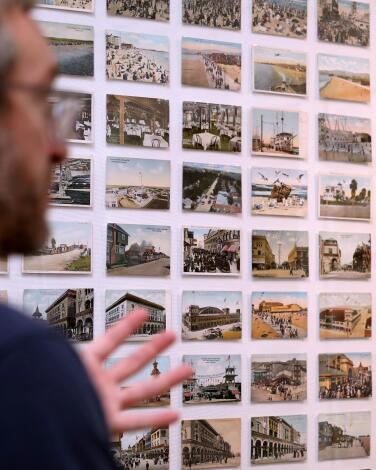
See colorful history come alive at Venice Heritage Museum
But you’ll get just as much — if not more — color by taking a seat in a tiny, darkened room off to one side and watching one of the looping interviews from the museum’s oral history project, which brings history alive with first-person accounts (65 to date) of living in the area. (Delores Deluce’s description of how the drag queen Divine ended up sharing her Venice pad is everything.) On your way out, consider throwing down $20 for one of those coloring books and see what color you can add. Admission is free, open Thursday to Sunday, 11 a.m. to 5 p.m.
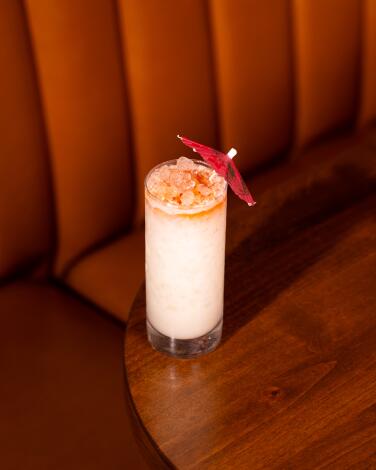
Raise a glass to the end of Prohibition at Townhouse
Which brings us around to the cocktails; a mix of the familiar (Townhouse’s take on the old-fashioned, the margarita and the too-trendy-to-die espresso martini) and the adventurous (a tiki drink pairing rum with house-made tepache and a tropical take on a clarified milk punch, for starters) that are worth popping in for even without the history lesson. But hey, since you’re here, why not take a second to raise your glass and toast the end of failed federal policy ushered in with the 21st Amendment.
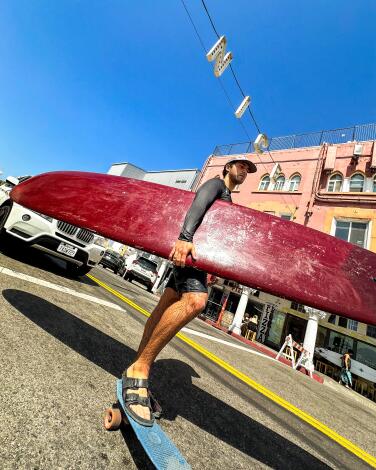
Take a selfie — safely — in front of the Venice sign
Registered as a federal trademark by the Venice Chamber of Commerce, which also oversees its upkeep, those six lighted letters also serve as a sort of heartbeat of the neighborhood, with bulb colors changing throughout the year to mark holidays (red, white and blue for Fourth of July, green for St. Patrick’s Day) and special occasions (pink for breast cancer awareness, blue to honor first responders’ efforts during the COVID shutdown), with a holiday sign lighting taking place each first Saturday of December.
While the organization jealously guards professional use of sign imagery (licensing it for events like a Tommy Hilfiger fashion show or the Rams’ return to L.A.), snapping away for your own enjoyment is highly encouraged — as long as you do it safely, says Venice Chamber of Commerce chief executive officer Donna Lasman.
“That intersection has a diagonal pedestrian crossing,” Lasman said, “so if you observe the [crossing] lights, you’ll have about 15 to 30 seconds to get the perfect photo.”
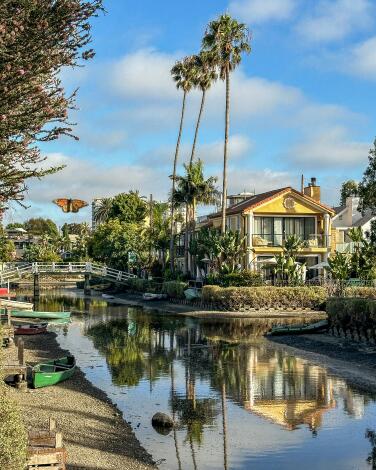
Embark on the right-sized stroll along the historic Venice Canals
There are plenty of places to begin your walking adventure of indeterminate length, but I’ve always had good luck finding street parking on the stretch of West Washington Boulevard just beyond the Baja Cantina where it crosses the Grand Canal. If you go this route, look for the Venice Canals walkway sign pointing the way at the northwest corner of Strongs Drive and West Washington Boulevard. Enter here and it’s a short 0.16-mile, four-minute meander along a sidewalk-style path to the first quaint arched bridge, after which you can either cross over and double back to where you started or continue exploring, with a new opportunity arising at each canal juncture and bridge. Whatever you decide, your route will take you past the backyards of the National Historic District’s cottages and duplexes on one side and the man-made canals on the other. Depending on the time of year and time of day (the water level can vary drastically based on the use of tide gates) you’ll spot flocks of ducklings and the occasional snowy egret doing their thing amid an assortment of moored kayaks, canoes and floating docks.
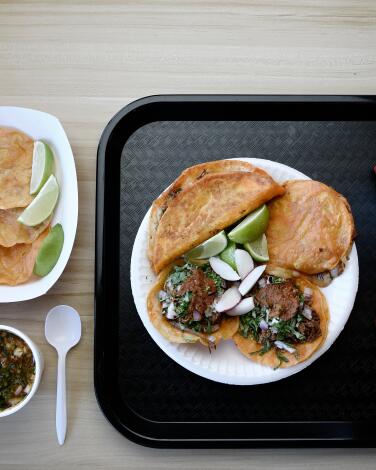
Find top-notch eats steps off the sand at Teddy's Red Tacos
If you’re the last one in that tiny queue you might feel unlucky. You are not. That’s partly because the line can be many times as long. But mostly it’s because it’s from this vantage point that you can see into the kitchen, with its sizzling grill and bubbling cauldrons of consomé (a dark red broth of tomatoes, roasted chiles, dried herbs and chuck steak) that seems to be splashed across the entire menu. Tortillas are dunked in it and grilled to a crisp to make tacos, mulitas, tostadas and quesadillas, and it’s ladled into cups to go. Order the deluxe plate ($16.99) and you’ll get all of that. When your order is ready, take your red plastic tray to a table outside and throw sharp elbows until you’ve had your fill. And if, at the end of this bliss, you find your fingers redolent of chiles and beef and your lips streaked with the crimson evidence of your conquest, worry not. The finger bowl of the Pacific Ocean awaits.
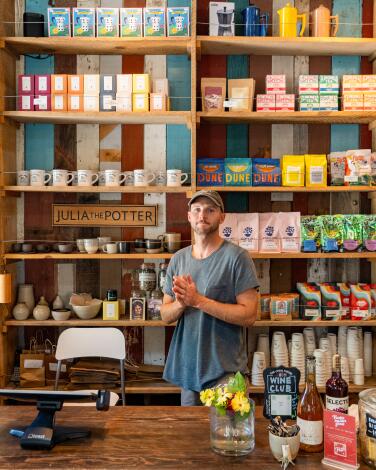
Stock up on gourmet groceries at Canal Market
In the first category, eclectic spirits (Wilder gin, Nosotros tequila, Humboldt Distillery vodka) on shelves, and lesser-known wines (Lo-Fi Cabernet Franc, Fallen Grape’s chilled red, Two Shepherds’ Trousseau Gri) in refrigerated cases line most of one wall. In the second category, a robust selection of locally skewing coffee and tea drinks are available over the coffee bar counter. The house pour is Amigo Coffee Roasters’ Wake N Bake, which the barista/register jockey can turn into all manner of coffee drink hot (including seasonal rose or lavender lattes) or cold (given a flush of nitrogen for mellowness). There’s also bagged coffee from Lip Service, Joshua Tree Coffee and Dune Coffee Roasters available as well as a selection of boxed teas from L.A.-based Flowerhead Tea.
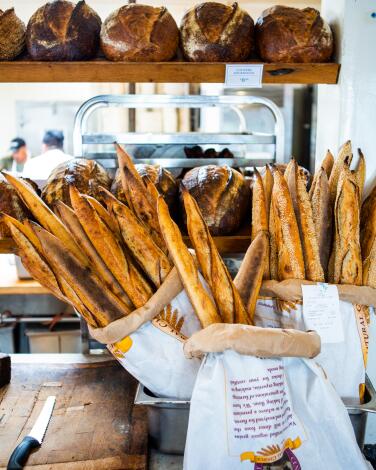
Grab rustic beach eats at Gjusta
Even though you’re beaching it, consider throwing in a couple of those giant loaves of bread for the home larder, a tub of green cheese pesto and a spiced mocha whose dusting of ghost pepper salt will have your tastebuds tingling while you work your way across town.
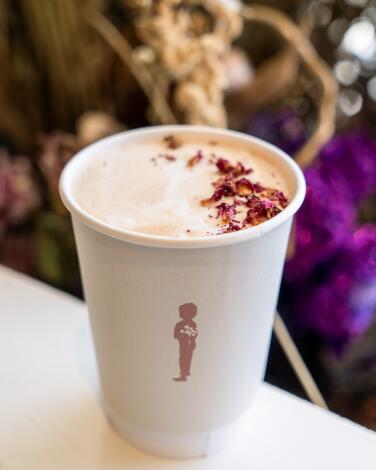
Grab a gift for them — and a coffee drink for you — at Flowerboy Project
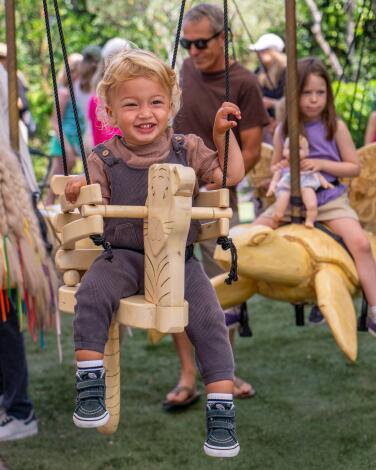
Take your kids on a magical, people-powered history lesson at the Venice Flying Carousel
Murez’s kinetic history lesson, which eventually will have a permanent home in Venice’s Centennial Park (she’s gathering petition signatures to speed up the stalled process), delights approximately 30 kids (120 pounds max) each hourlong session. They’re buckled onto Orson the duck, Joelle L’Escargot (a crown-wearing snail), Ribbon the unicorn or one of their carved companions for a brief ride propelled by the artist (or a helper), who stands in the center energetically cranking what looks like a ship’s wheel. “I’ve learned carousel etiquette,” Murez said about how long each ride lasts. “It goes on for the length of one song, so that’s about two minutes. I play a lot of Frank Sinatra, I play Brazilian jazz. I take requests.” My request, no doubt shared by the local parents who bring their children two or three times a month to squeal with delight as they soar around the circle: Give the magical menagerie its forever home as soon as possible. In addition to the scheduled hour each weekend day, Murez’s magical carousel is open by appointment for special events like birthday parties.
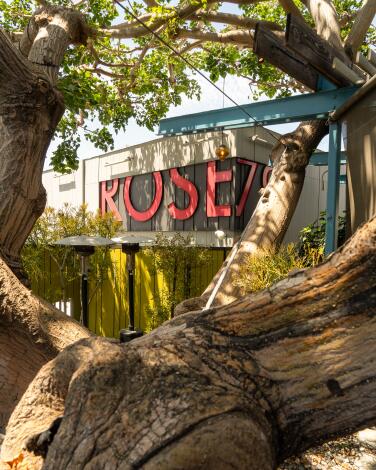
Brunch under a lucky bean tree at Rose Venice
Don’t worry if you haven’t found the meaning of brunch by the time you’re finished. This restaurant, and the tree beneath whose branches you contemplate, will be here when you come back to try again, just as it has since 1979. Maybe next time you’ll venture inside and explore the full-service espresso bar, the 200-seat dining room or the market. Or maybe you’ll return to your happy place beneath the lucky bean tree and venture deeper into that rose-pink menu. The answer is in there somewhere.
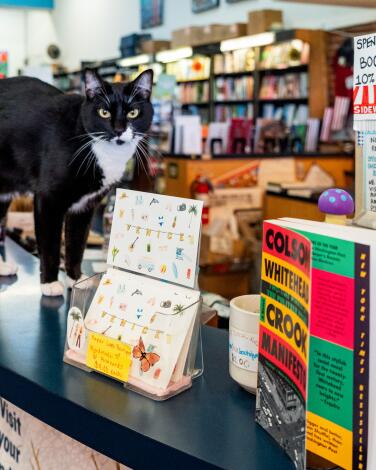
Discover your next unexpected beach read at Small World Books
Speaking of cats, the bookstore has two in-house fursters — Franny and Malcolm — whom you’re likely to find prowling the aisles as you browse. What could possibly be better than a well-curated beachside bookstore that comes with its own cats? One that comes with all that and a free half-hour of validated weekday parking (at the corner of Market and Speedway) in a part of town where such things are all but nonexistent.
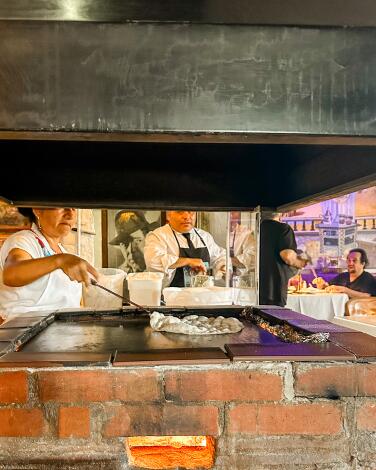
Celebrate with the usual suspects at Casablanca
The menu itself is a solid selection of Mexican dishes (burritos, tacos, quesadillas) with a handful of house specialties riffing on the Calamari steak (sautéed in butter and white wine and offered with a range of toppings, the most decadent of which is chopped crab and shrimp in a garlic sauce). Two things of particular note here. First are the fluffy tortillas — some as large as hubcaps — that are handmade at a station in the center of the dining room before being whisked to your table. Second is the deep bench of tequilas (250 options, according to the restaurant’s website) stocking the shelves of the cavern-like Rick’s Tequileria just inside the front door. If you order a margarita, ask for it to be made tableside; this results in a bar cart dubbed the Tequila Express to be rolled up and your drink prepared — with great flourish — before your eyes. (Take that, tableside Caesar!)
Although perfectly suitable for an intimate Rick-and-Ilsa dinner, the kitsch combined with the festive atmosphere makes it a good place for larger groups too; on a recent Saturday night, I counted four boisterous multigenerational tables of eight or more. So, to paraphrase Captain Renault’s famous line, next time you’re looking for someplace to celebrate a special occasion, round up the usual suspects and make your way here.
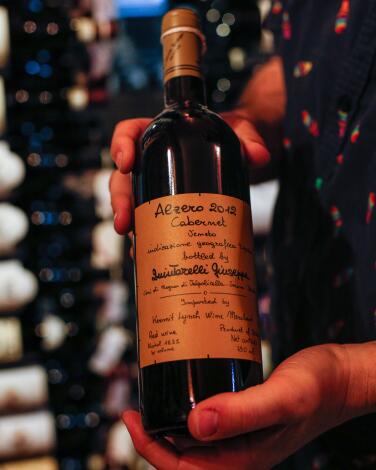
Seek out a pricy potent potable at Lincoln Fine Wines
Besides the one-of-everything inventory, there’s something else — a tiny little detail that you may not even notice — that reminds me of a bygone era of retail: Every single bottle in the joint sports either a business-card-size hangtag bearing a handwritten description and price, or the price written neatly across the front in white grease pencil. Unless you’re a former stockboy, that kind of flourish probably won’t mean much, but to me it makes the whole wine-buying experience feel even more personal and purposeful. And that’s not the vibe I’m used to getting in a wine shop or liquor store.
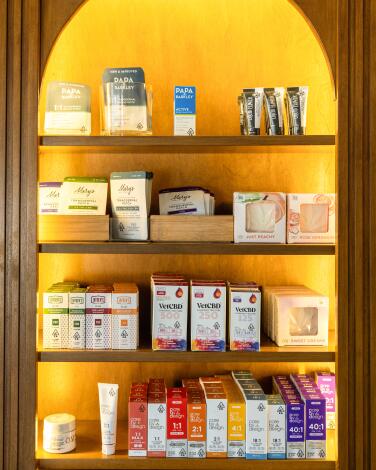
Shop for weed in high style at Green Goddess Collective
On top of that, it’s simply a beautiful space outside and in; one exterior wall is covered by an immense Hans Valør mural of a flowing-haired woman holding a seedling in her cupped hands (I’m gonna take a wild guess that’s the goddess). The interior vibe is more Art Deco apothecary than 21st century dispensary thanks to architectural elements like parquet floors and ornate light fixtures including a ballroom-worthy chandelier hanging over a curved glass case full of flower jars and tubes of prerolled joints (the latter of which are particularly popular here, a budtender told me recently, on account of the brisk tourist business). As if things couldn’t feel any more classy, there’s also free 20-minute validated parking across the street for dispensary customers who’ve made a purchase.
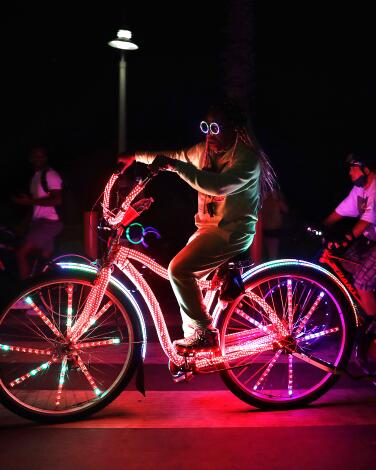
Roll bright with Venice Electric Light Parade
To join in the festivities, which take place every Sunday (unless it’s raining), all you need to do is join the folks who begin to gather at Windward Plaza an hour before sunset and start rolling at dusk. It’s free to participate.
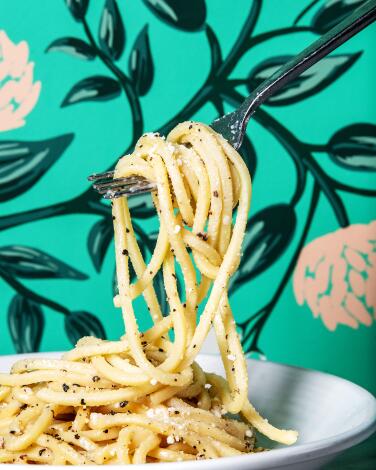
Behold the perfect plate of pasta at Felix
And, should you succeed, like I did on a summer Saturday evening after working OpenTable like Ticketmaster for a Rolling Stones show (outdoor patio, 6:30 p.m.), you will leave very happy. Funke’s strong suit is pasta (the dining room has a view of the glass-walled, temperature-controlled space where the dough is rolled out and hand-cut into shapes) and you’d be doing yourself — and all the effort that went into getting here — a disservice if you didn’t indulge. This high-profile pastaiolo’s preference is to cook the noodles just to an ultrafirm texture (which Jonathan Gold described in his review of the restaurant “as an extreme interpretation of what Italians call ‘al dente,’”) and sauce the dishes lightly (“dress it, don’t drown it” was one of the pasta-making rules Funke shared with Bon Appetit magazine back in 2020). That makes for a practically perfect pappardelle, strips of pasta as wide as packing tape cradling bits of salsiccia and porcini mushrooms and dusted with Parmigiano Reggiano, and a seriously superior spaghettoni (a wider diameter spaghetti) with chopped herbs and breadcrumbs with a salty scattering of anchovies across the top. (Pro tip: On the front end, don’t fill up on the sfincione bread — as good as it looks — and consider starting instead with a plate of fried squash blossoms stuffed with ricotta. They’re as delicious as they are delicate.) Happy and lucky indeed.
Sign up for The Wild
We’ll help you find the best places to hike, bike and run, as well as the perfect silent spots for meditation and yoga.
You may occasionally receive promotional content from the Los Angeles Times.



